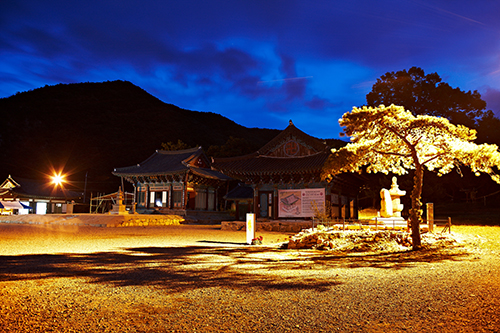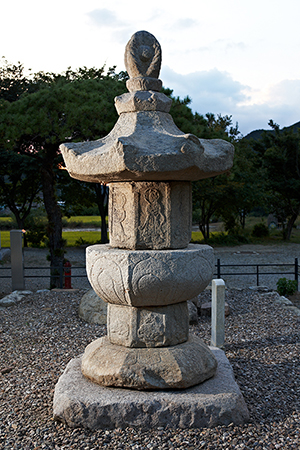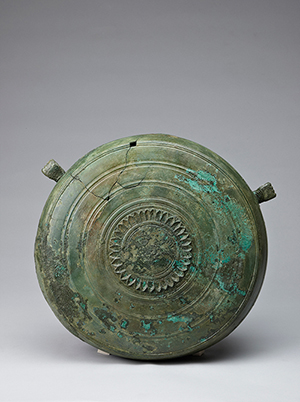English | The Banquet of Ingaksa
Page information
Author Jogye On19-06-14 14:03 Views7,412 Comments0Related links
Body
The Banquet of Ingaksa
The Rise and Fall of Ingaksa Temple
Located in Gunwi-gun, Gyeongsangbuk-do, Ingaksa Temple is an ancient temple established during the Unified Shilla period, approximately 1,400 years ago. Geologically, Ingaksa sits in Goro-myeon, Gunwi-gun, a valley that is completely surrounded by rocky terrain deep in the mountains, rising about 500m above sea level. Even now, it is a quiet farming town with the population of approximately 1,500 with a bus runs only once every hour. Mt. Hwasan stands within view from the valley, looking like a giraffe on the back, with a stream called Whicheon unhurriedly passing through in front of the temple. In this beautiful landscape, Ingaksa Temple is accompanied by a backdrop of a stiff cliff named Haksodae.

Whicheon and Haksodae
At present, Ingaksa is just a small temple that consists of only three dharma halls: Geukrak-jeon; the Paradise Hall; Myeongbu-jeon, the Judgement Hall; and Guksa-jeon, the National Teachers Hall, plus a three-tier pagoda and a seated triad statue that was founded in the early Goryeo Dynasty (918-1392). Despite its size, the temple houses the stupa (National Treasure No. 197) and the monument (Treasure No. 658) of National Preceptor Bogak. This is where National Preceptor Bogak, Venerable Ilyeon (一然, 1206-1289), spent his last five years of life from the ages of 79 to 84. While taking up residence at the temple, he completed one of the most recognized classics of all Korean literature, Samguk Yusa or The Historic Chronology of the Three Kingdoms, which is a collection of legends, folktales, and historical accounts relating to the Three Kingdoms of Korea (Goguryeo (37 BC-668 AD), Baekje (18 BC-660 AD), and Silla (57 BC-935AD)). Just taking this fact into account, Ingaksa deserves the title as the most sacred sanctum that embodies the intellectual history of the Korean people.

The overall view of Ingaksa

Guksa-jeon of Ingaksa
Ingaksa became the center of attention in history due to the Venerable Ilyeon. At the age of 78 at twilight, in 1283 while residing in the capital city of Gaegyeong, he was appointed as the National Preceptor, which was the highest honor for a monk at that time. In the same year that he was appointed as the National Preceptor, he left the capital and went to Ingaksa deep in the mountains to spend his final days. This is the story of his decision to move.
He wasn’t really fond of the capital city in the first place and so he asked for leave to go to Ingaksa, located near his hometown, citing a need to care for his aged mother. His sincere intention felt very noble, causing King Chungnyeol of Goryeo, the 25th ruler (r. 1274-1308), to be unable to ignore his request, and his leave was granted. Moreover, the king ordered to his direct commissioner, Hwang, Sumyeong (黃守命) to escort the Venerable in his departure. At last, he was able to care for his mother. Everyone praised his rare act of fulfilling his filial duty. The following year, she passed away at the age of 96. Subsequently, the Royal Court extended his residency at Ingaksa, had it repaired, and bestowed some land to the temple for him.
Thus, the Venerable left Gaegyeong, the capital, for Ingaksa to fulfill his filial duty to his aged mother at the end of her life. Though the 78-year-old National Teacher wholeheartedly cared for his mother, she passed away at the age of 96 in 1284. As a matter of fact, there is a grave that supposedly belongs to his mother nearby Ingaksa. After her passing, he continued his residence at Ingaksa until he reached nirvana. While there, he wrote one of the most recognized classics of all Korean literature, Samguk Yusa or The Historic Chronology of the Three Kingdoms.
During his residence at Ingaksa, the temple greatly flourished. For the five-year period of his time as abbot, Ingaksa twice hosted an assembly of dharma meeting of the nine sects of Seon (Zen) Buddhism (九山門都會를) in Korea at that time, important events that influenced the greater Buddhist community during the Goryeo period (918-1392). The monastery not only had received the political and financial support of the royal court, but also had placed themselves in a prominent position in the Buddhist community. (Photo 4 National Preceptor Bogak’s stupa)
Under the influential leadership of the Venerable Abbot Ilyeon, Ingaksa entered its golden age of prosperity and continued thriving until the late Goryeo Dynasty (918-1392). However, when the succeeding Joseon dynasty came into power and implemented the policy of advocating Confucianism while repressing Buddhism, fate took a toll on Ingaksa, and their status was not as high as in the past. Despite this, the temple was able to maintain its reputation and its substantial facilities up until the end of the Goryeo Dynasty.

National Preceptor Bogak’s stupa
The dharma halls of Ingaksa Temple were so large that Dancheong or its multi-colored paintings on the walls, pillars, or rafters were reflected in the clear water of the stream. In front of Geukrak-jeon (the Paradise Hall) stood the monument (Treasure No. 658) of National Preceptor Bogak, Venerable Ilyeon. The inscription on the monument was composed by a Goryeo scholar named Minji and engraved according to the writing style of a man named Wang, Heeji…. In the middle of the temple, there was the Golden Hall (the Great Hero Hall). To the west of the premises, there was a tall pavilion that contained the names of many visitors…. Besides these interesting structures, there are so many things to see in this temple that a day's visit isn't enough. It pains this passerby not to be able to see everything.
This passage was the part of the journals written by a scholar named Do Daesoon (1574-1653), who took short refuge in Ingaksa during the Imjin War (the first Japanese Invasion) in 1592. When examining this passage, we can infer that the extent of Ingaksa premises was quite considerable until 1595.
Just a short two years later, the splendor of Ingaksa Temple was devoured by a raging inferno. By 1597, in the midst of the seven-year-long war which followed the first invasion, the Japanese infiltrators deep into the country, all the way to the region where Ingaksa stood and set fires to all the buildings burning nearly everything to the ground. Though some of the Buddha halls were rebuilt by the 17th Century, the once prominent monastery was gone, managing only to carry on its legacy.
The Sensational Rise of Ingaksa
The story behind this remote, quiet temple once again gained the attention of the public thanks to the five excavations that were conducted in Ingaksa Temple from 1992 to 2009. While the fifth digging was carried out on October 26, 2008, numerous artifacts discovered around the area that was said to host the stupas for monks. Relics made of bronze or celadon, like a bronze gong, a bronze round box, a bowl, ewers or jugs, or an incense burner with a handle were found at the site. In particular, inside of the sealed bronze box, there were a bronze bowl, a bronze plate, and a figurine of a fantastical immortal creature called Kalavinka. All of these attracted the gaze of the people.

The relics found in Ingaksa
Specifically, there was the incense burner with a handle made of gold and brass. That was followed by two bronze ewers, a stupa-shaped 7-tier incense box made of bronze complete with a lid, a cylinder-shaped-two-tier double layer bronze box (원통형의청동이중합靑銅二重盒); a bronze gong, three pieces of bronze bowls and lids, and seven celadon pieces with sunray designs.
To explain further, such an incense burner with a long handle was actually used by many monks during various ceremonies. It is rare for this type of incense burner to be found in Korea, making this find an extremely valuable piece of history. The incense burner found in Ingaksa is known for its intricate lion design on the end of the handle. The overall appearance of the burner is beautiful with its elaborate details.

The incense burner with a handle made of gold and
brass

The handle of the incense burner
Ewers or jugs are an instrument that is utilized in offering clear water to the Buddha. During the excavations, two ewers were found at the Ingaksa site. Among the discovered jugs from the Unified Silla Kingdom Period (668-935) so far, they seem to predate the others. Also found was a stupa-shaped 7-tier incense box made of bronze complete with a top, the lines from the top to the bottom flow gracefully. This similar stupa design has known to be utilized even today as a sarira container. In the box, traces of burnt incense prove that it was also used to store incense.

The 7-tier bronze incense box
The bronze gong is an instrument that is commonly used to assemble people in temples. This newly discovered bronze gong is decorated with a circle in the front and its center that created unique sounds when hitting, and is embellished with lotus petals. This lotus petal decoration is the first of its kind ever unearthed.

The bronze gong
Among the relics found at the Ingaksa stupa site, there include seven celadon or porcelain pieces. These celadon pieces were not produced in Korea but directly imported from China. These were made between the late 8th to the early 9th century in Yuezhou, China as tea bowls. These artifacts are quite significant relics that could be utilized in estimating their dating.

The tea bowl celadons
Last is the figurine of a 4-cm-high Kalavinka that was found inside of the bronze gong. Kalavinka is a fantastical immortal creature that lives in the Pure Land and Utmost Bliss of Amitabha Buddha in the West. It supposedly takes the form of a human head and the torso of a bird that sings in a beautiful voice. This half human half bird appears to play a pipe, and there is a pin at the bottom indicating that it might have been a decoration for something or somewhere.

Kalavinka
Notably, some of the relics resemble the offering tools found in an underground stone chamber in a mausoleum, where the image of Buddha is enshrined, of Chan or Seon Master Heze Shenhui, which was excavated at the site called Baoying Temple (寶應寺址, 683~758) in Luoyang, Henan, China. Master Heze Shenhui was the great disciple of the Sixth Patriarch Huineng (慧能) of Chan Buddhism so he was considered to be an important figure in Chinese Buddhism. In his underground mausoleum, excavators unearthed many metal craftworks. Based on the inscription discovered, the relics found in the stupa of Chan Master Heze Shenhui were clearly made before 765. Among these artifacts, the ewers, the incense burners, and the incense box share a lot of resemblance to Ingaksa’s craftworks in their appearances. Additionally, they also share the fact that these were all found around the area of the stupa of a monk.
Given the striking similarities between the discovered artifacts at the stupa of Chan Master Heze Shenhui and the unearth metal craftworks and celadons of Ingaksa, we can confirm that there was a lively exchange of goods between Unified Silla and China during this period. Considering the many relics found in Ingaksa Temple in Gunwi-gun, which is a long way from Gyeongju, the capital city of the Silla Kingdom, we can presume the great scope of the exchanges that took place with ancient China, and the enormous influence they had over the kingdom as well.
The articles of offering tools unearthed through the archeological excavations were unprecedented and rare finds. Presently, Korean museums do house some articles that resemble the discovered relics of Ingaksa, but the origins of most of these items are uncertain and trace back to the time after the Goryeo period (918-1392). Thus, these discoveries have aided in filling the gap in known art history for the Unified Silla period (668-935). In this regard, the artifacts from the Ingaksa site are estimated to have been made around as early as the 8th century or the 9th century at the latest. Furthermore, they hold significant value just in the fact of their discovery.
Additionally, there had been speculation that Ingaksa could have been established during the Silla period (57 BC-935AD) based on some records from the subsequent period, but there hadn’t been any actual historical accounts about Ingaksa before the appointment of Venerable Ilyeon’s abbotship, and its past remained as a mystery for some time. However, the discovery of the relics from the Unified Silla Kingdom period at the Ingaksa site corroborated the speculated notion that the monastery was founded during that period. It also revealed the fact that even before Venerable Ilyeon became the abbot of the temple, the extent of the facilities was already quite considerable.
The historical and artistic value of the discovered offering items from the Ingaksa site have been properly recognized on May 2 last year, as they were designated as National Treasure No. 2222. Looking forward to the future, there is no double that Ingaksa Temple is expected to play a very important role in research in the fields of archeology, art history, Buddhist history, as well as Korean history as a whole.

* Central Buddhist Museum Exhibition Information
2019 Theme Exhibition “The Banquet of Buddha-mind”
April 3 to July 31, 2019
The special exhibition will feature the discovered offering tools and relics of the Unified Silla period (668-935) from Ingaksa Temple.


